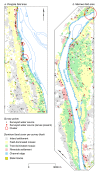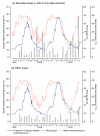Spatial and temporal distribution of the malaria mosquito Anopheles arabiensis in northern Sudan: influence of environmental factors and implications for vector control
- PMID: 19500425
- PMCID: PMC2698915
- DOI: 10.1186/1475-2875-8-123
Spatial and temporal distribution of the malaria mosquito Anopheles arabiensis in northern Sudan: influence of environmental factors and implications for vector control
Abstract
Background: Malaria is an important public health problem in northern Sudan, but little is known about the dynamics of its transmission. Given the characteristic low densities of Anopheles arabiensis and the difficult terrain in this area, future vector control strategies are likely to be based on area-wide integrated pest management (AW-IPM) that may include the sterile insect technique (SIT). To support the planning and implementation of future AW-IPM activities, larval surveys were carried out to provide key data on spatial and seasonal dynamics of local vector populations.
Methods: Monthly cross-sectional larval surveys were carried out between March 2005 and May 2007 in two localities (Dongola and Merowe) adjacent to the river Nile. A stratified random sampling strategy based on the use of Remote Sensing (RS), Geographical Information Systems (GIS) and the Global Positioning System (GPS) was used to select survey locations. Breeding sites were mapped using GPS and data on larval density and breeding site characteristics were recorded using handheld computers. Bivariate and multivariate logistic regression models were used to identify breeding site characteristics associated with increased risk of presence of larvae. Seasonal patterns in the proportion of breeding sites positive for larvae were compared visually to contemporaneous data on climate and river height.
Results: Of a total of 3,349 aquatic habitats sampled, 321 (9.6%) contained An. arabiensis larvae. The frequency with which larvae were found varied markedly by habitat type. Although most positive sites were associated with temporary standing water around the margins of the main Nile channel, larvae were also found at brickworks and in areas of leaking pipes and canals - often far from the river. Close to the Nile channel, a distinct seasonal pattern in larval populations was evident and appeared to be linked to the rise and fall of the river level. These patterns were not evident in vector populations breeding in artificial water sources away from the river.
Conclusion: The GIS-based survey strategy developed in this study provides key data on the population dynamics of An. arabiensis in Northern State. Quantitative estimates of the contributions of various habitat types and their proximity to settlements provide a basis for planning a strategy for reducing malaria risk by elimination of the vector population.
Figures



Similar articles
-
Characterisation of larval habitats, species composition and factors associated with the seasonal abundance of mosquito fauna in Gezira, Sudan.Infect Dis Poverty. 2017 Feb 8;6(1):23. doi: 10.1186/s40249-017-0242-1. Infect Dis Poverty. 2017. PMID: 28173839 Free PMC article.
-
Anopheles larval species composition and characterization of breeding habitats in two localities in the Ghibe River Basin, southwestern Ethiopia.Malar J. 2020 Feb 11;19(1):65. doi: 10.1186/s12936-020-3145-8. Malar J. 2020. PMID: 32046734 Free PMC article.
-
Sibling species of the major malaria vector Anopheles gambiae display divergent preferences for aquatic breeding sites in southern Nigeria.Malar J. 2024 Feb 27;23(1):60. doi: 10.1186/s12936-024-04871-9. Malar J. 2024. PMID: 38413961 Free PMC article.
-
Field site selection: getting it right first time around.Malar J. 2009 Nov 16;8 Suppl 2(Suppl 2):S9. doi: 10.1186/1475-2875-8-S2-S9. Malar J. 2009. PMID: 19917079 Free PMC article. Review.
-
New directions for malaria vector control using geography and geospatial analysis.Adv Parasitol. 2024;125:1-52. doi: 10.1016/bs.apar.2024.06.001. Epub 2024 Jun 26. Adv Parasitol. 2024. PMID: 39095110 Review.
Cited by
-
The role of oxygen depletion and subsequent radioprotective effects during irradiation of mosquito pupae in water.Parasit Vectors. 2020 Apr 17;13(1):198. doi: 10.1186/s13071-020-04069-3. Parasit Vectors. 2020. PMID: 32303257 Free PMC article.
-
A Regional Model for Malaria Vector Developmental Habitats Evaluated Using Explicit, Pond-Resolving Surface Hydrology Simulations.PLoS One. 2016 Mar 22;11(3):e0150626. doi: 10.1371/journal.pone.0150626. eCollection 2016. PLoS One. 2016. PMID: 27003834 Free PMC article.
-
Mapping the breeding sites of Anopheles gambiae s. l. in areas of residual malaria transmission in central western Senegal.PLoS One. 2020 Dec 11;15(12):e0236607. doi: 10.1371/journal.pone.0236607. eCollection 2020. PLoS One. 2020. PMID: 33306671 Free PMC article.
-
Anopheles arabiensis larval habitats characterization and Anopheles species diversity in water bodies from Jozini, KwaZulu-Natal Province.Malar J. 2025 Feb 20;24(1):52. doi: 10.1186/s12936-025-05287-9. Malar J. 2025. PMID: 39979987 Free PMC article.
-
Incorporating hydrology into climate suitability models changes projections of malaria transmission in Africa.Nat Commun. 2020 Aug 28;11(1):4353. doi: 10.1038/s41467-020-18239-5. Nat Commun. 2020. PMID: 32859908 Free PMC article.
References
-
- FMOH . Annual health statistical report 2006. Khartoum: Federal Ministry of Health, Republic of Sudan; 2006.
-
- Dukeen M, Omer S. Ecology of the malaria vector Anopheles arabiensis Patton (Diptera: Culicidae) by the Nile in northern Sudan. Bull Entomol Res. 1986;76:451–467.
-
- Lewis DJ. The anopheline mosquitoes of Sudan. Bull Entomol Res. 1956;47:475–494.
-
- Azrag RS. Microsatellite and mitochondrial genetic differentiation of Anopheles arabiensis Patton (Diptera: Culicidae) along the river Nile. Khartoum: University of Khartoum; 2008.
Publication types
MeSH terms
LinkOut - more resources
Full Text Sources
Medical

